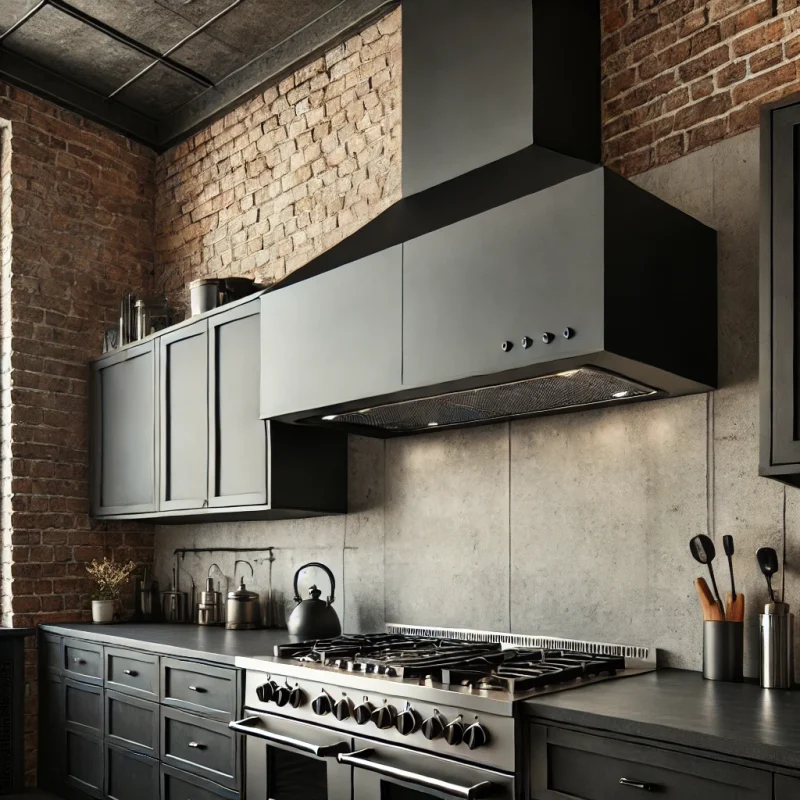Hoods
Energy-efficient hood
Energy-efficient hoods are constantly growing in popularity, as they not only purify the air, but also significantly reduce energy consumption. Equipped with modern sensors that adaptively determine air quality and automatically adjust the operating mode, reducing energy consumption and ensuring zero unnecessary energy loss. An energy-efficient hood provides noise-free and efficient operation, which helps both protect the environment and reduce the user's energy costs.
3. Exhaust noise
The noise level of the hood is an important aspect when the user makes a selection. , which would create an unpleasant working environment. However, modern devices adopt noise reduction technology, which reduces the disturbing effects on the user. Silent , because they provide effective air purification without excessive noise being perceived, which is a great choice for kitchens where noise can interfere with other activities.
4. Vent design
The design of the hood is not only functional, but it is also one of the main factors when a consumer chooses a hood for their kitchen. Modern ones come in various designs and styles, such as built-in, wall-mounted or mechanical. They fit perfectly into the interior of the kitchen, which significantly increases not only functionality, but also beauty. The design of the hood determines not only its visual appeal, but also the parameters necessary for its efficiency, such as filtration and energy consumption.
Built-in hood
A built-in hood, as its name suggests, is a device that is completely integrated into a wall or kitchen cabinet. This helps to optimize space and creates a more minimalist effect. Built-in hoods are most popular with those looking for a less conspicuous technical device that still performs its functions effectively. This type of hood often features a sleeker and more elegant design, making them a perfect fit for any modern kitchen interior.
6. Hang me a towel.
Wall-mounted hoods are a type that is flexible enough to fit into any type of kitchen, including minimalist designs. Their design is more fashionable and distinctive, which is especially desirable for younger consumers. These hoods have a strong layout and effective cleaning capabilities, while their different styles ensure elegance and minimal space consumption. Wall-mounted hoods are ideal for people who create a modern environment in the kitchen, and want quality equipment that seamlessly blends with furniture and interiors.
7. Exhaust filters
Hood filters are responsible for cleaning the air. The quality of the filters has a significant impact on the efficiency of the hood. Revolutionary filters that use carbon filtration or HEPA filtration provide cleaner air and reduce the accumulation of soot or dirt. The best filters provide regular maintenance and an easy replacement process. They provide the highest quality air purification, which is more beneficial for both health and kitchen cleanliness.
8. Power consumption of the hood
The energy consumption of a hood is related to its efficiency. An energy-efficient hood uses less energy, which results in lower electricity bills for the user. Some hoods are equipped with automatic temperature control, which further reduces energy consumption. Reducing energy consumption also benefits the environment, as less energy means less waste of resources. Paying attention to the hood's energy consumption can help you reduce your long-term costs.
9. Installing the hood
Installing a range hood often requires the help of a specialist, although many new models are quite easy to install by do-it-yourself. You just need to choose the right size and follow the instructions. Installing a built-in range hood requires a more serious and professional approach, as a properly positioned range hood and its proper pump integration ensure optimal performance and minimize energy consumption.
10. Hood maintenance and repair
Hood maintenance and repair contribute to the in-depth operation of the device and ensure its long service life. Cleaning is necessary periodically, especially replacing filters and removing old grease deposits. Some important tips are: regular cleaning, replacing filters on time and requesting repair services when the device functions are worn out. As a result, the hood will work longer and more efficiently.
11. Compatibility of the hood design and interior
As mentioned, the design of the hood is very important, as it is closely related to the interior of the kitchen. This device should be chosen so that it harmoniously integrates with the overall style of the kitchen. Traditional, modern or minimalist style hoods can all fit well into the interior, as their design and function allow them to match.
12. High-quality exhaust fan
A high-quality hood is one that not only effectively purifies the air, but also provides a high thermal transfer rate. Such a hood is very effective because it provides the user with clean air and non-conductive ranges that are tailored to them.
13. Choosing a hood
The choice of hood depends on several factors, including the size of the kitchen, cooking modes, and the user's personal needs.

14. Exhaust and space saving
The hood plays an important role in saving space. Built-in hoods are especially suitable for small kitchens, as they are integrated into the furniture and do not require additional space. This is very convenient, because this type of device not only cleans the air, but also completely takes up the kitchen space. Hanging hoods, which are more often installed in a standard form, also help to optimize space, but their design allows for even more diverse styles and comfort. A hood that is correctly selected and integrated helps to use the available space in your kitchen.
15. Protection against exhaust fumes
Removing soot in the kitchen is important to improve air quality and make the living environment safe for health. High-quality hoods easily remove not only grease, but also soot that is formed during cooking processes. In addition, hood systems come with various types of filters that filter out soot and other harmful particles. Hood systems also work quickly to prevent the accumulation of soot and thus maintain the cleanliness of the kitchen.
16. Ventilation and humidity
Hoods are also used to manage humidity, especially in kitchens where there are problems with high humidity. This type of hood is equipped with special filters and a system that helps regulate humidity. Incorrect humidity, such as excessive humidity, leads to the growth of mold and fungi, which are dangerous to health. That is why hoods can be used not only for air purification, but also for humidity control.
17. Maintenance of ventilation devices
The efficient operation of a hood depends largely on proper maintenance. Filters and other components need to be checked and cleaned regularly. Some models require the replacement of old filters in order to function in an updated mode. Hood models equipped with transparent filters allow the user to realize in time when they need to be replaced. Maintenance of the hood allows the device to work for a long time and efficiently, as a result of which the user will see its perfect performance for years.
18. Exhaust dimensions
The size of the hood has a great influence on its selection, as it must adapt to the layout and requirements of the kitchen. For small kitchens, the best option is compact hoods, which have minimal dimensions, but still provide good performance. For larger kitchens, where powerful cleaning is required, more powerful hoods will be appropriate, which cover a wide area and provide quick cleaning of the entire area. The size must be taken into account so that the hood fully meets specific needs.
19. Exhaust materials
The materials used to make the hood are also an important aspect. High-quality hoods are made of steel or aluminum, which not only look attractive but also provide high durability. High durability and strength help to make the hood durable and effective. At the same time, some hoods can be made of plastic or other durable materials, which also reduces the price of the product, but their durability is shorter.
20. Characteristics of hoods
The features of the hoods help us make a choice when it comes to choosing a hood that fully meets our needs. Depending on the features, hoods can be of different power, have additional functions such as vital filtration systems, smart sensors and temperature control. Hoods with higher technology provide cleaner air, use less energy and can be installed in different styles of kitchens.


